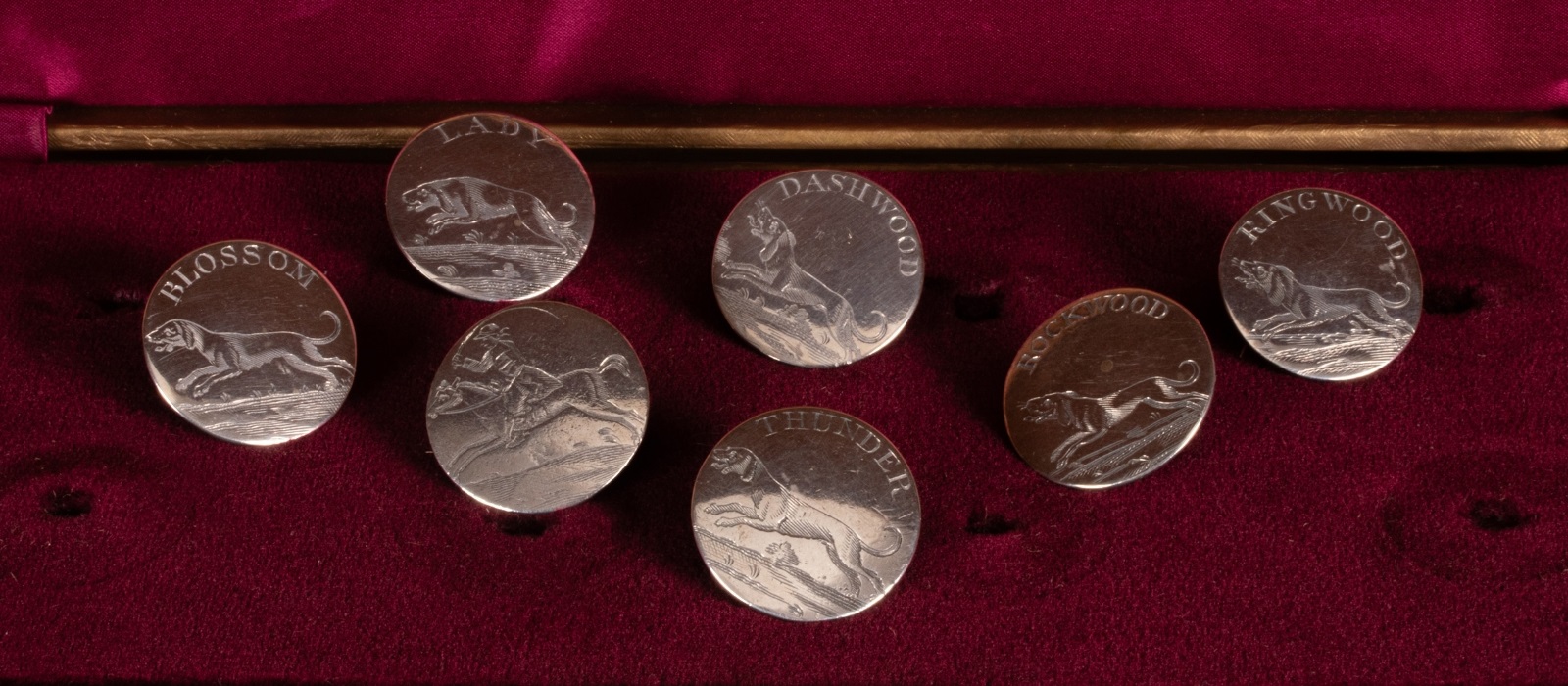

A private collection of hunt buttons made for a successful sale, with keen collectors making for a sold rate of over 90%. A set of 18th century silver hunting buttons connected to the legendary English huntsman John Peel (1776–1854) saw competitive bidding with the buttons finally selling for £8, 974 against a pre-sale estimate of £3,000-£5,000. Some of the seven buttons in the set feature names his hounds and one of them engraved with a mounted huntsman.
A private collection of hunt buttons made for a successful sale, with keen collectors making for a sold rate of over 90%. A set of 18th century silver hunting buttons connected to the legendary English huntsman John Peel (1776–1854) saw competitive bidding with the buttons finally selling for £8, 974 against a pre-sale estimate of £3,000-£5,000. The buttons were gifted by John Peel’s widow Mary Peel, to her housekeeper, Sarah Bean and were then passed down through generations of the Bean family, until they were sold by her Great-Great Grandson in 2003. Some of the seven buttons in the set feature names of hounds, such as Rockwood, Thunder, Dashwood, Blossom, Ringwood and Lady and one of them was engraved with a mounted huntsman.

John Peel who is the subject of the famous 19th century song D'ye ken John Peel (‘ken’ meaning 'to know' in some dialects of Northern England and Scotland), was a farmer from Cumbria in the Lake District. He was known for his overriding passion and dedication to hunting, which also made him a controversial figure. He had a large family of 12 children and a farm to manage, but all of his spare time was devoted to hunting. Peel hunted in the traditional Lake district manner at the time, which was to ride your horse to the hunting area and dismount, to hunt on foot. His relationship to his horse is believed to have been extraordinary, with the animal knowing his master’s quirks so well, that at the end of each day's hunt the horse would find its own way to the finishing point, to wait for Peel.
At the time, foxes (which were predominantly grey in this area of England up until approximately 1934 and known as the ‘greyhound’ fox), were seen as a pest, destroying sheep across the region. However, Peel was known to let many of them go, if he could get to them before his hounds did (exhausted, the hounds would sometimes run over 80 miles during the hunt). Peel was known far and wide after the song that was composed for him, however some criticised him for romanticising hunting.
Peel owned a large pack of hounds, which became as renowned as himself, with some featuring in the later verses of the popular song. His names for them were: Lively, Britain, Charmer, Burthwaite, Stormy, Welcome, Dancer, Crafty, Bellman, Towler, Delly, Drunkard, Glory, Lifter, Bowler Lucy, Merry, Lilter, Royal, Lofty, Melody, Leader and Ranter.
The John Peel song is thought to have originated in 1832, at the end of a tiring day’s hunting, when Peel and a friend, John Woodcock Graves (1795-1886) were relaxing and chatting about the hunt at Graves’ home in the village of Caldbeck, Cumbria. Graves' daughter came into the room humming an old Borders tune called Bonnie Annie or Canny Annie, that her grandmother had always sung to her. Soon they were all chatting about it and Graves grabbed a pen and paper to write down the words to fit the music. His first phrase was "D'ye ken John Peel with his coat so gray" and it wasn’t long before he had the first verse written in the Lakeland dialect. It is said that even though Peel was a hardened Lakelander, he cried with emotion on hearing it, to which Graves responded by saying: "By jove, Peel, you'll be sung about when we've both been run to earth!" The song had its debut in the Rising Sun Inn in Caldbeck and later became the Lake District's anthem.
Some years later (and following Peel’s death in 1854), a choirmaster and bass singer named William Metcalfe from the cathedral choir in Carlisle, heard the song and liked it, but thought it could be developed and feature more jovial music. He wrote a new melody and as a seasoned singer, performed it in London, at a celebratory dinner of the Cumberland Benevolent Association in 1869. It was met with great approval and became a countrywide hit. Metcalfe died in 1909 and is buried in Carlisle. John Peel is buried in Caldbeck churchyard in Cumbria with other members of his family. Graves emigrated to Tasmania in 1833 and died there in 1886 aged 91, having never benefited from the proceeds of his notorious song.